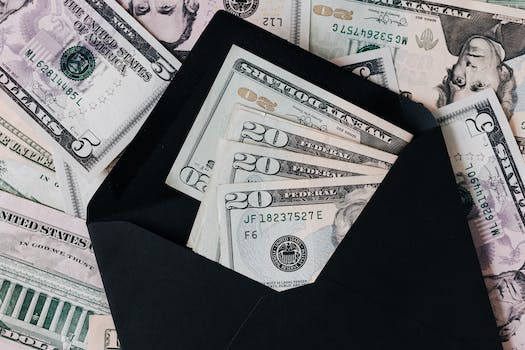How To Save Money Fast
Introduction

Introduction: Saving money is an essential aspect of financial planning. It helps you to achieve your financial goals and secure your future. However, saving money can be challenging, especially when you have a limited income or unexpected expenses. In this article, we will discuss some practical tips on how to save money fast and efficiently.
10 Simple Ways to Cut Your Monthly Expenses
Saving money is a goal that many people have, but it can be difficult to know where to start. Fortunately, there are many simple ways to cut your monthly expenses and start saving money fast. Here are 10 tips to help you get started.
1. Create a budget
The first step to saving money is to create a budget. This will help you see where your money is going and identify areas where you can cut back. Start by listing all of your monthly expenses, including rent or mortgage payments, utilities, groceries, and entertainment. Then, compare your expenses to your income and see where you can make adjustments.
2. Cut back on eating out
Eating out can be a major expense, especially if you do it frequently. Try to limit your restaurant visits and cook at home instead. Not only will this save you money, but it can also be healthier and more enjoyable.
3. Cancel unnecessary subscriptions
Do you have subscriptions to magazines, streaming services, or other services that you don’t use? Cancel them and save yourself some money each month.
4. Use coupons and discounts
Coupons and discounts can help you save money on everything from groceries to clothing. Look for coupons online or in your local newspaper, and take advantage of sales and discounts whenever possible.
5. Shop around for insurance
Insurance can be a major expense, but you may be able to save money by shopping around for better rates. Compare prices from different providers and see if you can get a better deal.
6. Cut back on energy usage
Reducing your energy usage can help you save money on your monthly utility bills. Turn off lights and electronics when you’re not using them, and consider using energy-efficient appliances and light bulbs.
7. Use public transportation
If you live in an area with good public transportation, consider using it instead of driving. This can save you money on gas and car maintenance, as well as reduce your carbon footprint.
8. Buy generic brands
Generic brands can be just as good as name-brand products, but they’re often much cheaper. Try buying generic versions of your favorite products and see if you can save money without sacrificing quality.
9. Cut back on alcohol and tobacco
Alcohol and tobacco can be expensive habits. If you’re trying to save money, consider cutting back or quitting altogether. Not only will this save you money, but it can also improve your health.
10. Sell unused items
Do you have items in your home that you no longer use or need? Consider selling them and making some extra cash. You can sell items online or at a garage sale, and use the money to pay off debt or save for the future.
In conclusion, there are many simple ways to cut your monthly expenses and start saving money fast. By creating a budget, cutting back on eating out, canceling unnecessary subscriptions, using coupons and discounts, shopping around for insurance, cutting back on energy usage, using public transportation, buying generic brands, cutting back on alcohol and tobacco, and selling unused items, you can save money and achieve your financial goals. So why not start today?
The Ultimate Guide to Couponing for Beginners
Are you looking for ways to save money fast? Couponing is a great way to do just that! It may seem overwhelming at first, but with a little bit of practice, you can become a pro in no time. In this ultimate guide to couponing for beginners, we will cover everything you need to know to start saving money today.
First, let’s talk about where to find coupons. The most common place to find coupons is in your Sunday newspaper. You can also find them online on websites such as Coupons.com, RetailMeNot, and SmartSource. Another great way to find coupons is by signing up for loyalty programs at your favorite stores. They often send out exclusive coupons and discounts to their members.
Once you have your coupons, it’s important to stay organized. You don’t want to miss out on a great deal because you couldn’t find the coupon you needed. One way to stay organized is by using a coupon binder. You can organize your coupons by category, such as food, household items, and personal care products. Another option is to use a coupon app on your phone, such as Ibotta or Checkout 51. These apps allow you to scan your receipts and earn cash back on your purchases.
Now that you have your coupons and you’re organized, it’s time to start shopping! One of the most important things to remember when couponing is to only buy what you need. Don’t be tempted to buy something just because you have a coupon for it. Stick to your shopping list and only buy items that you would normally purchase.
Another tip for saving money is to stack your coupons. This means using a manufacturer coupon and a store coupon on the same item. For example, if you have a $1 off coupon for a box of cereal and the store has a $0.50 off coupon for the same cereal, you can use both coupons and save $1.50 on your purchase.
It’s also important to pay attention to sales and promotions. Many stores offer buy one, get one free deals or discounts on certain items. If you have a coupon for that item, you can save even more money. Don’t forget to check the clearance section as well. You may be able to find great deals on items that are being discontinued or are out of season.
Finally, don’t be afraid to ask for a rain check. If an item is on sale but is out of stock, ask the store for a rain check. This will allow you to purchase the item at the sale price when it becomes available again. This is a great way to save money on items that you need but aren’t in a rush to purchase.
In conclusion, couponing is a great way to save money fast. By finding coupons, staying organized, and shopping smart, you can save hundreds of dollars each year. Remember to only buy what you need, stack your coupons, and take advantage of sales and promotions. With a little bit of practice, you can become a couponing pro in no time!
5 DIY Home Improvement Projects That Will Save You Money
Are you looking for ways to save money fast? One way to do so is by tackling some DIY home improvement projects. Not only will you save money by doing it yourself, but you’ll also increase the value of your home. Here are five DIY home improvement projects that will save you money.
1. Paint Your Walls
One of the easiest and most cost-effective ways to update your home is by painting your walls. A fresh coat of paint can transform a room and make it look brand new. Plus, you can save money by doing it yourself instead of hiring a professional. All you need is some paint, brushes, and rollers, and you’re ready to go.
2. Install a Programmable Thermostat
If you’re looking to save money on your energy bills, consider installing a programmable thermostat. This will allow you to set the temperature in your home based on your schedule, so you’re not wasting energy when you’re not home. Plus, you can save money by doing it yourself instead of hiring an HVAC technician.
3. Update Your Lighting
Another way to update your home and save money is by updating your lighting. Switching to LED bulbs can save you money on your energy bills, and installing new light fixtures can give your home a fresh look. You can even install dimmer switches to save even more money on your energy bills.
4. Refinish Your Cabinets
If your kitchen cabinets are looking a little worn, consider refinishing them instead of replacing them. This is a cost-effective way to update your kitchen and make it look brand new. All you need is some sandpaper, paint or stain, and a little elbow grease.
5. Install a Water Filtration System
If you’re tired of buying bottled water, consider installing a water filtration system in your home. This will allow you to have clean, filtered water straight from your tap, saving you money on bottled water. Plus, you can save money by doing it yourself instead of hiring a plumber.
In conclusion, there are many DIY home improvement projects that can save you money. From painting your walls to installing a water filtration system, these projects can update your home and increase its value. Plus, you’ll save money by doing it yourself instead of hiring a professional. So, why not tackle one of these projects this weekend and start saving money?
How to Meal Plan and Save Money on Groceries
Are you tired of constantly overspending on groceries? Do you want to learn how to save money fast? One of the best ways to cut down on expenses is by meal planning. Not only does it save you money, but it also saves you time and reduces food waste. Here are some tips on how to meal plan and save money on groceries.
Firstly, take inventory of what you already have in your pantry, fridge, and freezer. This will help you avoid buying unnecessary items and ensure that you use up what you already have. Make a list of the ingredients you need for the meals you plan to make for the week. Stick to your list and avoid impulse buying.
Next, plan your meals for the week. Look for recipes that use similar ingredients to reduce waste and save money. Consider incorporating cheaper protein sources such as beans, lentils, and tofu into your meals. You can also plan to have meatless meals a few times a week to save money on meat.
When shopping for groceries, buy in bulk when possible. This is especially true for non-perishable items such as rice, pasta, and canned goods. Buying in bulk can save you money in the long run and reduce the number of trips you need to make to the grocery store.
Another way to save money on groceries is by buying generic or store-brand items. These items are often just as good as name-brand products but cost less. Compare prices and choose the cheaper option when possible.
Consider shopping at discount grocery stores or using coupons to save money. Discount stores often have lower prices than traditional grocery stores, and coupons can help you save even more. However, be careful not to buy items just because they are on sale or have a coupon. Stick to your list and only buy what you need.
When cooking, make extra portions and freeze them for later. This will save you time and money in the long run. You can also use leftovers to make new meals. For example, leftover chicken can be used to make a chicken salad or added to a stir-fry.
Finally, be mindful of food waste. Plan your meals based on what you already have and what needs to be used up. Use wilted vegetables in soups or stews, and turn stale bread into croutons or breadcrumbs. By reducing food waste, you can save money and help the environment.
In conclusion, meal planning is a great way to save money on groceries. By taking inventory of what you already have, planning your meals, buying in bulk, choosing generic items, shopping at discount stores, and being mindful of food waste, you can save money and reduce your grocery bill. Give it a try and see how much you can save!
The Benefits of a No-Spend Challenge and How to Do It
Saving money can be a daunting task, especially when you have bills to pay and a limited income. However, there are ways to save money fast without sacrificing your quality of life. One of the most effective ways to save money quickly is by taking on a no-spend challenge.
A no-spend challenge is exactly what it sounds like: a period of time where you commit to not spending any money on non-essential items. This means no eating out, no shopping sprees, and no unnecessary purchases. The benefits of a no-spend challenge are numerous, and it can be a great way to jumpstart your savings.
First and foremost, a no-spend challenge can help you identify areas where you are overspending. When you commit to not spending any money on non-essential items, you are forced to take a hard look at your spending habits. You may realize that you are spending more money than you thought on things like coffee or eating out. This awareness can help you make more informed decisions about your spending in the future.
Another benefit of a no-spend challenge is that it can help you break bad spending habits. If you are used to buying things on impulse or without much thought, a no-spend challenge can help you break that cycle. By committing to not spending any money on non-essential items, you are forced to be more intentional about your purchases. This can help you develop better spending habits in the long run.
So, how do you do a no-spend challenge? The first step is to set a timeframe. You can start with a week or two, or you can challenge yourself to a month-long no-spend challenge. The key is to choose a timeframe that is realistic for you. Next, you need to define what counts as a non-essential item. This will vary from person to person, but generally, non-essential items include things like eating out, shopping for clothes or home decor, and buying things you don’t need.
Once you have defined what counts as a non-essential item, it’s time to prepare. This means stocking up on groceries and other essentials before your no-spend challenge begins. You should also make a plan for how you will handle any unexpected expenses that may arise during your challenge. For example, if your car breaks down and you need to pay for repairs, you may need to dip into your savings. The key is to be prepared for these situations so that you don’t feel like you have failed your challenge.
During your no-spend challenge, it’s important to stay motivated. One way to do this is by tracking your progress. You can use a spreadsheet or a journal to keep track of your spending and your progress towards your savings goals. You can also find support from friends or family members who are also trying to save money. Having a support system can help you stay accountable and motivated throughout your challenge.
In conclusion, a no-spend challenge can be a great way to save money quickly and develop better spending habits. By committing to not spending any money on non-essential items, you can identify areas where you are overspending and break bad spending habits. To do a no-spend challenge, you need to set a timeframe, define what counts as a non-essential item, and prepare for unexpected expenses. Staying motivated and tracking your progress can also help you succeed. So, if you’re looking for a way to save money fast, consider taking on a no-spend challenge.
7 Ways to Make Extra Money on the Side
Are you looking for ways to save money fast? One of the best ways to do so is by making extra money on the side. With a little bit of effort and creativity, you can easily earn some extra cash to put towards your savings goals. Here are seven ways to make extra money on the side:
1. Sell items you no longer need or use
One of the easiest ways to make extra money is by selling items you no longer need or use. This could include clothing, electronics, furniture, and more. You can sell these items online through websites like eBay, Craigslist, or Facebook Marketplace. Not only will you make some extra cash, but you’ll also declutter your home in the process.
2. Participate in online surveys
Many companies are willing to pay for your opinion through online surveys. You can sign up for websites like Swagbucks, Survey Junkie, or Vindale Research to start earning money for your opinions. While you won’t get rich from taking surveys, it’s an easy way to make some extra cash in your spare time.
3. Rent out a spare room
If you have a spare room in your home, consider renting it out on Airbnb. This is a great way to make extra money, especially if you live in a popular tourist destination. You can set your own rates and choose when you want to rent out your space.
4. Offer pet-sitting services
If you love animals, consider offering pet-sitting services in your spare time. You can advertise your services on websites like Rover or Care.com. Not only will you get to spend time with furry friends, but you’ll also make some extra cash.
5. Do odd jobs for people in your community
There are always people in your community who need help with odd jobs like yard work, cleaning, or running errands. You can advertise your services on websites like TaskRabbit or Craigslist. This is a great way to make extra money while helping out your neighbors.
6. Drive for a ride-sharing service
If you have a car and some spare time, consider driving for a ride-sharing service like Uber or Lyft. You can set your own hours and work as much or as little as you want. This is a great way to make extra money, especially if you live in a busy city.
7. Sell your skills online
If you have a skill like writing, graphic design, or programming, consider selling your services online. You can advertise your skills on websites like Fiverr or Upwork. This is a great way to make extra money doing something you’re good at.
In conclusion, there are many ways to make extra money on the side. Whether you sell items you no longer need, participate in online surveys, or offer pet-sitting services, there are plenty of opportunities to earn some extra cash. By putting in a little bit of effort and creativity, you can save money fast and reach your financial goals.
The Importance of Building an Emergency Fund and How to Start
Saving money can be a daunting task, especially when you have bills to pay and a limited income. However, having an emergency fund is crucial to your financial stability. An emergency fund is a savings account that you can use in case of unexpected expenses, such as medical bills, car repairs, or job loss. In this article, we will discuss the importance of building an emergency fund and how to start.
Why is an emergency fund important?
An emergency fund is important because it provides a safety net for unexpected expenses. Without an emergency fund, you may have to rely on credit cards or loans to cover these expenses, which can lead to debt and financial stress. Having an emergency fund can also give you peace of mind, knowing that you have a cushion to fall back on in case of an emergency.
How much should you save?
The amount you should save in your emergency fund depends on your individual circumstances. A good rule of thumb is to save at least three to six months’ worth of living expenses. This includes your rent or mortgage, utilities, food, transportation, and any other necessary expenses. If you have dependents or a high-risk job, you may want to save more.
How to start building your emergency fund
1. Set a savings goal: Determine how much you want to save and set a deadline for yourself. This will help you stay motivated and focused on your goal.
2. Create a budget: Review your monthly expenses and identify areas where you can cut back. This could include eating out less, canceling subscriptions, or finding cheaper alternatives for your regular expenses.
3. Automate your savings: Set up automatic transfers from your checking account to your savings account each month. This will help you save consistently and avoid the temptation to spend the money elsewhere.
4. Use windfalls wisely: If you receive a bonus at work or a tax refund, consider putting a portion of it towards your emergency fund.
5. Consider a side hustle: If you have extra time, consider taking on a side job or selling items you no longer need. This can help you earn extra money to put towards your emergency fund.
6. Stay committed: Building an emergency fund takes time and discipline. Stay committed to your goal and celebrate your progress along the way.
In conclusion, building an emergency fund is an important step towards financial stability. By setting a savings goal, creating a budget, automating your savings, using windfalls wisely, considering a side hustle, and staying committed, you can start building your emergency fund today. Remember, every little bit counts, and the peace of mind that comes with having an emergency fund is priceless.
Conclusion
Conclusion: Saving money fast requires discipline, commitment, and a willingness to make sacrifices. By creating a budget, cutting unnecessary expenses, increasing income, and finding ways to save on everyday purchases, anyone can start building their savings quickly. It’s important to remember that saving money is a long-term goal, and small changes can add up over time. With dedication and persistence, anyone can achieve their financial goals and secure their financial future.







